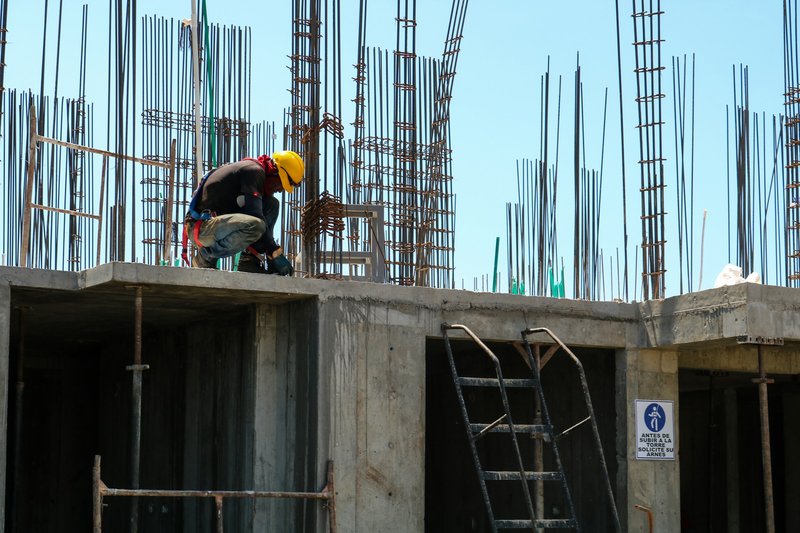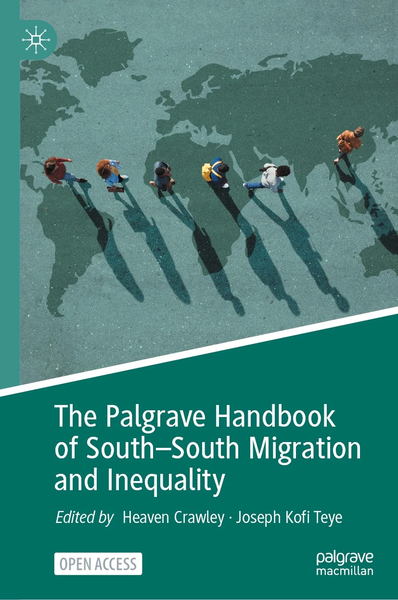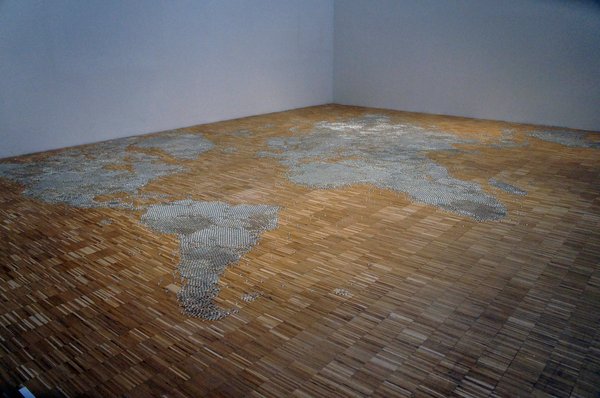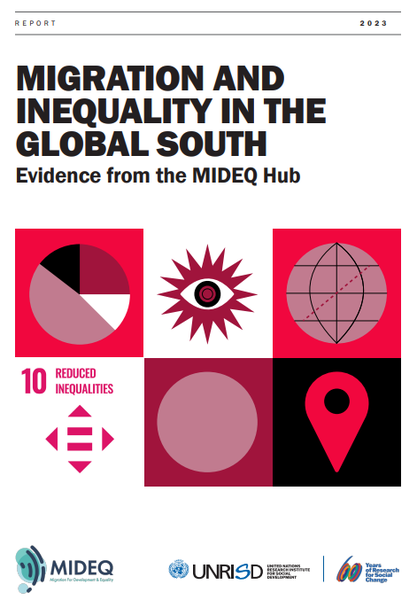
Migrant community in Rayong, Thailand. Photo via ILO/Pichit Phromkade. CC BY-NC-ND 2.0 DEED.
This blog post was originally published by the United Nations University Centre for Policy Research. Find the original blog on their website.
This month saw the publication of The Palgrave Handbook of South-South Migration and Inequality which examines the phenomenon of South-South migration and its relationship to inequality in the Global South, where at least a third of all international migration takes place. Centring the knowledge and perspectives of those living and working in the Global South is critical if we want to understand the relationships between South-South migration and inequality. It is also vital to harness the potential benefits of migration for development, and for the well-being of migrants and their families.
Drawing on contributions from nearly 70 leading migration scholars, mainly from the Global South, the Handbook challenges dominant conceptualizations of migration, offering new perspectives and insights that can inform theoretical and policy understandings, and unlock migration’s development potential.
Scale and patterns of South-South migration
South-South migration has a long history, albeit under differing economic and political conditions. Historically, large scale South-South migration flows were mostly enforced and involuntary, involving both inter- and intra-regional destinations to various colonies of the Global North. The transatlantic slave trade was one of the largest historical migrations between countries of the Global South, taking place mainly between the countries of western, central and southern Africa and what is now known as Brazil. This trade has enduring impacts on the prospects for peace and development.
While existing research overwhelmingly focuses on movements from the Global South to the Global North, South-South migration has been – and remains – a significant share of global population movements. Migration between the countries of the Global South now constitutes at least a third of all international migration, and the absence of documentation and formal regulation of flows means that the proportion is probably even higher.
Migration between the countries of the Global South now constitutes at least a third of all international migration, and the absence of documentation and formal regulation of flows means that the proportion is probably even higher.
Indeed, in some places, almost all migration is to a neighbouring country in the Global South. Take for example migration from Burkina Faso to Cote d’Ivoire, one of the largest migration flows in the world, but one that is rarely talked about or analysed by migration scholars outside the region.
South-South migration is also increasing in absolute terms. For example, African countries hosted 24.7 million migrants in 2017, up from 19.3 million in 1990, a 28 per cent increase. Almost all these migrants were born somewhere else in Africa. As Yaro and Setrana point out, more than 80 per cent of African migrants do not leave the continent despite perceptions to the contrary. Within the Global South, Asia-to-Asia migration, especially that related to migration from slower-growing developing Asia to faster-growing developing Asia, is most significant. Asia was the origin of over 40 per cent of the world’s international migrants in 2020 (around 115 million). In the same year, more than half (69 million) were residing in other countries in Asia, a significant increase from 2015, when around 61 million were estimated to be living within the continent.

Young migrants from Zimbabwe heading towards South Africa. Photo credit Dylan Thomas / UKaid
But forms of South-South migration are also changing. Extra-regional migration is on the rise as more international migrants travel further distances in search of protection, work, education, and other opportunities. Chapters in the Handbook explore the experiences of Chinese migrants in Ghana and the drivers of migration from various African countries to South America, questioning simplistic explanations based on outdated push-pull models, and drawing attention to the agency and diversity of migrants.
The importance of Global South perspectives
Migration scholarship is heavily skewed towards the Global North where research is largely designed and led, and where governments and international organizations increasingly fund research to inform policy development. This leads to a disproportionate focus on South-North and North-North migration, and categories of migrant defined in law and policy to make sense of – and increasingly contain – migration flows. Moreover, because existing migration research is dominated by theories and concepts derived from the Global North, it is inevitably partial. It often fails to fully grasp the complex social, as well as economic and political factors, associated with migration in the Global South, and the intersectional inequalities with which migration is associated.
Moreover, because existing migration research is dominated by theories and concepts derived from the Global North, it is inevitably partial.
By contrast, the Palgrave Handbook of South-South Migration and Inequality is dominated by the views and perspectives of those living in, or originating from, the Global South, with more than two-thirds of the chapters written by Global South scholars. These contributions provide new insights into migration processes in the Global South and some of them directly challenge dominant migration theories developed by scholars in the Global North that ignore context-specific economic, political, and social processes.
Many of the contributors are part of the Migration for Development and Equality (MIDEQ) Hub which unpacks the complex and multi-dimensional relationships between migration and inequality in the context of the Global South. MIDEQ’s work directly addresses knowledge gaps, decentring or decolonizing the production of knowledge about migration and its consequences away from the Global North with the aim of ensuring that policymakers, programme specialists, and donors have the understanding and evidence they need to harness the development potential of migration for individuals, households, communities, and the countries of the Global South.
Challenging dominant migration theory and practice
The Handbook is divided into four parts, each highlighting often overlooked mobility patterns within and between regions of the Global South, as well as the inequalities faced by those who move. Key cross-cutting themes include gender, race, poverty and income inequality, migration decision making, intermediaries,remittances, technology, climate change, food security, and migration governance.
Many of the chapters challenge long-held assumptions about decision-making processes and the reasons people move, arguing that it is impossible to fully understand migration processes and outcomes without engaging with the socio-economic contexts within which migration occurs, as well as the structural inequalities which shape migration possibilities. Three chapters are illustrative.
Many of the chapters challenge long-held assumptions about decision-making processes and the reasons people move, arguing that it is impossible to fully understand migration processes and outcomes without engaging with the socio-economic contexts within which migration occurs …
In their chapter on Hadiya migration from Ethiopia to South Africa, Dereje Feyissa, Meron Zeleke, and Fana Gebresenbet critique the individualist thrust in migration studies and the assumed autonomous agency of prospective migrants, especially in the context of the Global South. The authors suggest migration is a collective rather than an individual project, as typically assumed by migration scholars, and argue that the success of Hadiya migration to South Africa is largely due to its collective nature at the various stages of migration processes—from decision-making to the various forms of social support that enable cost sharing and ease the process of settlement at destination.
In their chapter examining trends and characteristics of migrants’ social and economic inclusion in South America, Rosas and Zapata argue that there are significant gaps with respect to migrants’ and refugees’ access to social and economic rights in Argentina, Colombia, Chile, Ecuador, and Peru which result from the intertwining of intersectional inequalities — related to gender, age, and race/ethnicity, among others — and an array of pre-existing social, political, and economic inequalities. The complex overlaying of these inequalities challenges dominant ways of thinking about migration. On the one hand, South–South migration does not fit into the rationale of the neoclassical model, given that the benefits of migrating barely compensate for the costs. On the other hand, conventional assimilationist perspectives on migrant integration overlook destination settings where living conditions are less than optimal for everyone.

Construction worker in Colombia. Photo by Ivan Henao on Unsplash.
In their chapter on the experiences of Haitians on the migrant trails in the Americas, Louis Herns Marcelin and Toni Cela argue that migrant vulnerability in destination countries cannot be understood outside of the situations and living conditions of the countries from which migrants originate. Haiti, they argue, epitomises this continuum of intersectional inequities, creating what they call a “path dependency” for vulnerability. For the largely undocumented Haitian population trekking across the Americas in search of a new life, the vulnerability they experienced—and are attempting to escape—in their homeland signals to social actors on these trails and in destination countries that those migrating are not protected by their own government and can be exploited.
Taken as a whole, this Handbook represents an important contribution to our understanding of the nature of South-South migration in general, and its relationship to inequalities in particular. It moves us away from the frequently examined South–North and North–North movements to look instead at human mobility within the Global South, challenging dominant conceptualizations of migration and offering new perspectives and insights that can inform theoretical and policy understandings. It encourages us to move away from conceptualizations of migrants as victims and instead to view them as actors, for whom migration is often an important livelihood strategy and who are increasingly mobilizing to create new forms of solidarity regardless of the inequalities of the systems of which they are a part. And it highlights the importance of Global South perspectives in offering fresh insights and thinking to a policy space which remains challenging and politically contentious.
The Palgrave Handbook of South-South Migration, edited by Heaven Crawley (UNU-CPR) and Joseph Kofi Teye (University of Ghana), can be downloaded free of charge here.
Join UNU-CPR, the University of Ghana and the MIDEQ Hub on 1 February for the online launch of the Handbook.



